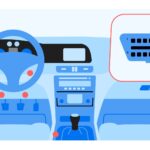An OBD2 scanner is an essential tool for any car enthusiast or DIY mechanic. It allows you to access your vehicle’s onboard computer, read diagnostic trouble codes (DTCs), and understand what’s ailing your car. With the right scanner, you can save money on repairs and gain a deeper understanding of your vehicle’s health. This guide will help you choose the Best Diy Obd2 Scanner for your needs.
The On-Board Diagnostics II (OBD2) port, mandated by U.S. law for all vehicles manufactured since 1996, provides a standardized interface for accessing vehicle diagnostic information. This multi-pin connector, typically located under the driver’s side dash, allows an OBD2 scanner to communicate with the car’s computer. This connection unlocks a wealth of information about your vehicle’s performance and potential problems.
OBD2 scanners come in a wide range of functionalities, from basic code readers to advanced diagnostic tools. They not only “scan” for trouble codes; they also read, interpret, and in some cases, even offer troubleshooting guidance. Some advanced scanners can display Technical Service Bulletins (TSBs) related to specific codes, and most can clear the codes after a repair is completed, turning off the Check Engine Light (CEL). High-end “bi-directional” scanners can even perform tests and limited programming of vehicle systems.
While many auto parts stores offer code reading services, or even loan or rent scanners, owning your own OBD2 scanner empowers you to diagnose car problems anytime, anywhere. It’s a valuable investment for anyone who enjoys working on their own car. This ability to quickly diagnose issues can save you time and potentially prevent minor problems from becoming major ones.
Choosing the right OBD2 scanner depends on your needs and budget. Basic code readers are affordable and sufficient for reading and clearing codes. More advanced scanners offer features like live data streaming, graphing sensor data, and specific system diagnostics. Consider factors like vehicle compatibility, ease of use, and available features when selecting a scanner.
If you’re looking to troubleshoot and perform basic repairs yourself, a mid-range OBD2 scanner is often a good choice. These scanners typically offer a balance of functionality and affordability, providing the features you need without breaking the bank. Features like freeze frame data, which captures the vehicle’s operating conditions at the time a code was set, can be invaluable for diagnosing intermittent problems.
Ultimately, the best DIY OBD2 scanner is the one that meets your individual needs and allows you to confidently diagnose and address your vehicle’s issues. Research different models, compare features, and read reviews to find the perfect scanner for your DIY automotive projects. Empower yourself with the knowledge and tools to maintain your vehicle and keep it running smoothly.

